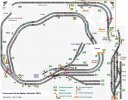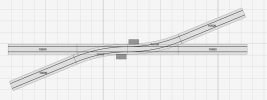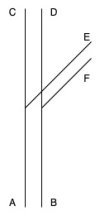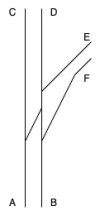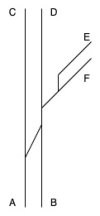The other way of thinking about a double slip is to take a ladder junction (two facing turnouts) and slide the two turnouts closer until they overlap. Your abstraction explains the mechanical complexity (e.g. why are there four sets of point blades rather than just two?), but thinking about it as two distinct turnouts crammed together helps model why only a single route can be active through the junction at a time.
Looking at the upper picture above, the trick one needs to remember is that the motor on the right controls which track is active on the left, and vice-versa.
The main (only?) advantage of a double slip over a ladder is that it takes a heck of a lot less room. Not only does the ladder need two distinct turnouts, but also enough separation to protect against the reverse curve that would otherwise result from the crossing track.
Another interesting tidbit:
- A ladder junction requires 2 crossings (one on each turnout)
- A double slip requires 4 crossings
- A double crossover (2nd picture) requires 8 crossings (four on the diamond crossing, and one on each turnout)

